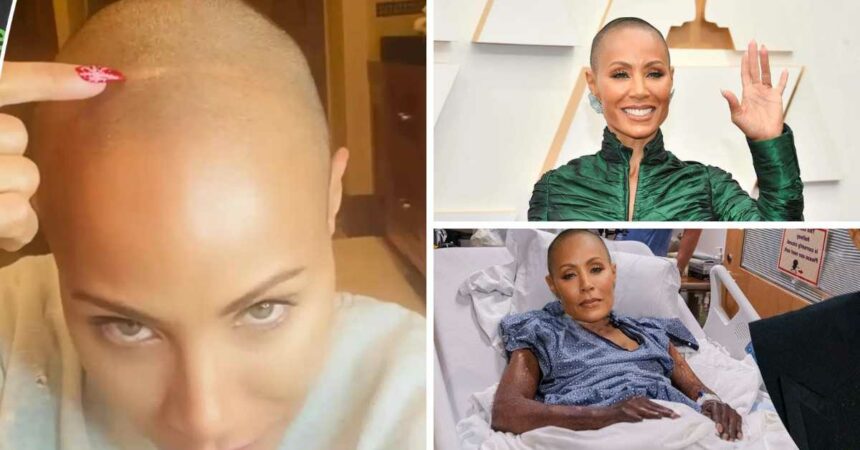After Chris Rock made a joke about Will Smith’s wife Jada Pinkett Smith’s buzz cut during the 94th Academy Awards ceremony on March 27, the actor slapped Rock across the face. Jada Pinkett Smith, an actress who married Will Smith in 1997, has been dealing with the hair loss symptoms of alopecia.
In 2018, Jada disclosed that she had been diagnosed. During the Oscars, Rock commented on Jada’s newly shorn head, saying he hoped she would reprise her role as GI Jane in the sequel. Will Smith did not appreciate the joke and walked up to the stage to slap the comic.
Awareness of Alopecia Areata has Increased Since Pinkett Smith’s Diagnosis
For the first time in 2018, Pinkett Smith discussed her alopecia diagnosis on Red Table Talk. The actress opened up about the “terrifying” experience of losing “handfuls of hair” in the shower and how it led to her choice to have her hair cut off.
She went into detail about the treatments she was undergoing, including the steroid treatment she stated was improving but not curing her bald spots. In recent years, Pinkett Smith has sported short hairstyles, hair turbans, and close cropping for red-carpet appearances. She talked about her decision to shave her head as the hair loss got worse.
When she announced the pregnancy in December, she said on Instagram, “This is going to be a little more difficult to hide, so I thought I’d just share it so y’all are not asking any questions.” She attached a snapshot of herself beaming under her new short hairstyle.
Some people tend to only have a few weak points. There are four main categories of alopecia.
Certainly, here are some key points about the different types of alopecia areata:
Alopecia Areata Totalis:
-
- Results in total hair loss.
- Hair loss affects the entire scalp, leaving no hair remaining.
- Eyebrows, eyelashes, and body hair may also be affected in some cases.
Alopecia Areata Universalis:
-
- Causes hair loss not only on the scalp but also elsewhere on the body.
- Complete loss of hair, including eyebrows, eyelashes, and body hair.
- Affects all areas with hair follicles.
Diffuse Alopecia Areata:
-
- Results in sudden thinning of the hair without the development of bald patches.
- Hair loss occurs evenly throughout the scalp.
- Hair may appear visibly thinner, but no distinct bald spots.
Ophiasis Alopecia Areata:
-
- Characterized by circular thinning of the hair.
- Most commonly occurs on the sides and rear of the head.
- Hair loss patterns may resemble a wave-like or snake-like shape along the scalp.
These different types of alopecia areata are variations of an autoimmune condition where the body’s immune system mistakenly attacks hair follicles, leading to hair loss. The specific presentation and severity of hair loss can vary among individuals, depending on the type of alopecia areata they have.
Pinkett Smith’s band-shaped hair loss began in December of last year. After posting a video of herself going fully bald on Instagram, the actress explained, “Mama’s gonna have to take it down to the scalp so nobody thinks she got brain surgery or something.” I’ve decided to make peace with my alopecia and work with it instead of against it.
How it started: How it’s going: pic.twitter.com/rwnNtY92cw
— Jada Pinkett Smith (@jadapsmith) July 15, 2021
The actress opened up in the video about her experience with alopecia and the unexpected challenges that her condition might provide. At this point, she stated, all she could do was chuckle.
You all know how hard it is for me to deal with alopecia, and then suddenly, one day, this line appeared. See for yourself. The problem is that it just appeared like that, making it harder for me to conceal. “I figured I’d just post this so none of y’all have any questions,” Jada says in the clip.
You can also click on the following links for access to other, related content:
- Mark Hurd Cancer: Former HP CEO Dies At 62!!
- Jamie Raskin Illness Recovery from Stage III Colon Cancer
- Die Hard Star Bonnie Bedelia Illness Opens Up About Her Cancer Battle!!
Why Does Alopecia Areata Happen?
Alopecia areata can affect both males and women with similar frequency. The American Academy of Dermatology (AAD) reports that onset can occur at any age, but that many people experience the first symptoms in their teens, and that the majority of those who develop the disorder do so before the age of 30.
A study conducted in the United States in 2018 indicated that Black and Hispanic women are more likely to get alopecia than other ethnic groups.
The risk of developing alopecia is higher in people who already have a medical condition such as vitiligo, atopic dermatitis, asthma, or thyroid illness. A 2019 study revealed that vitamin D insufficiency may play an impact, but additional investigation is needed.
However, a late-stage study published on March 26, 2022, in the New England Journal of Medicine suggests that the rheumatoid arthritis medicine baricitinib may cause considerable hair regrowth in those with alopecia areata.
How Recoverable Is Alopecia?
Alopecia areata is not curable, but it can be managed with pharmacological and natural therapies, according to experts. Topical medications, injections, oral medications, and light therapy are all options for medical treatment.
The senior dermatological specialist of Sri Balaji Action Medical Institute, Dr Vijay Singhal, told Indian Express that zinc and biotin, aloe vera and topical gels, and onion juice are frequently prescribed for application to the scalp.
Other useful oils include tea tree, rosemary, lavender, peppermint, coconut, castor, olive, and jojoba. Patients should eat a low-inflammatory diet rich in meat and vegetables, as well as ginseng, green tea, and Chinese hibiscus, according to Dr. Singhal.

